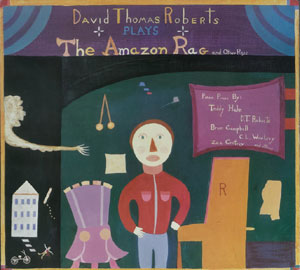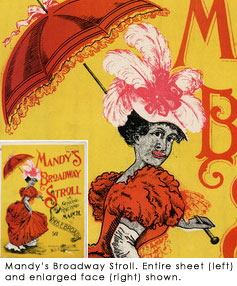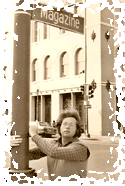The Amazon Rag

(Stomp Off Records, York, PA, 1985 - LP)
Status: Out of Print
Introduction
One of the most influential figures in my life, Edgar Allan Poe, wrote in the introduction to his collected poems: "For me, poetry has not been a purpose, but a passion." For me, ragtime has been a relentless passion. Though it is only one of my many creative vehicles, it is inseparable from me and so rootedly fixed in my consciousness that I balk at envisioning existing, or ever having existed, without it. So strong is this bond that I have been led to imagine it as a pre-experiential force predating my birth and perhaps even the existence of ragtime.
This album is a diverse collection of compositions from eight decades and is the last of three Stomp Off LPs to be based upon my sessions of June-July, 1981 at York College.
Track Listing
- The Amazon Rag (Teddy Hahn, 1904). Teddy Hahn (1882-1961) was a violinist from Cincinnati. His The Amazon Rag is an example of the adventuresome ragtime tastes of Cincinnati publisher John Arnold who presented some of the most unusual efforts in the early stages of the medium. It is in the third section of this rag that Hahn's imagination finds the fresh territory that makes this one of the most important statements from the Ohio Valley. The textural variety pervading the piece plus the coda-like extension of the D section are also memorable.
- One O' Them Things! (James Chapman and Leroy Smith, 1904).The opening section of this plaintive St. Louis anomaly is generally believed to be the earliest published example of twelve-bar blues. (Note the similarity between the writing for right hand here and that of Mamie Desdoume's Blues as recalled by Ferdinand Morton at Morton's Library of Congress sessions.) The second strain is reminiscent of Joplin with its chromatic thirds in bars 1-4, after which it shifts to A minor to sound stark, and repeated fourths and fifths in the right hand. The cadence of this section is singularly poignant. The trio concludes with a stoptime passage, after which a bridge calls back the twelve-bar theme for a wistful conclusion.
- Little Wabash Special (Tom Shea, 1964).
Tom Shea (1931-1982) was one of the few authentic purveyors of folk ragtime in recent years. He developed a deeply personal ragtime language as evidenced in this brilliant country rag.
I learned Little Wabash Special after hearing Tom perform it in St. Louis in 1979. Subsequently it was picked up by pianists Molly Kaufmann, Virginia Tichenor and the Queen City Jazz Band. Aptly, it became the title cut of Shea's Stomp Off LP appearing in 1982. - The Watermelon Trust (Harry C. Thomason, 1906). This lyrical work is spiced throughout with some of early ragtime's most affecting uses of non-chord tones. Its composer, author of the equally beautiful A Black Bawl (which utilizes the sixth and seventh degrees of the scale in the same vein) remains one of ragtime's many mystery figures.
- The Pen Pals (David Thomas Roberts, 1981). One of my most traditional efforts, this countryfied essay in A flat and D flat was composed after my exposure to a particular girlface in pen pal literature received by my friend William Bailey. The variation ending the piece was played with considerable freedom in the first months of the rag's life but took this fixed form after an effective improvisation I performed at the Norwegian Seamen's Church in New Orleans in 1982.
- Funny Bones (Calvin Lee Woolsey, 1909). This was the first published rag of rural Missouri's composer and physician, C. L. Woolsey (1884-1946). Born and raised around the northwest Missouri town of Braymer, Woolsey was a quintessential spinner of folk rags, a hero of down-home creativity embodying the aspirations of tunesmiths and tinkerers throughout the Midwest/South. (For more about Woolsey and my research in Braymer, see the notes on An Album of Early Folk Rags and Through the Bottomlands on Stomp Off.)
Funny Bones begins with a 16-bar introduction in A minor. Windswept, lonely and alarming, it wails from a hillside within view of distant farms before yielding dramatically to the gentle humor of the opening strain. B is a thirty-two bar entity of classic Missouri lyricism, hinting of folksong. The trio is a radiant, beguiling vignette showing us small town ragtime at its highest quality. A whimsical bluenote infects the first statement of this strain as it turns around for the repeat. The finale is a naughty, strutting circle-of-fifths which alone would make Funny Bones worthy of occasional performance. - Nickel in the Slot (Zez Confrey, 1923). High prankishness and cleverness at the service of the quasi-sublime mark this typically ingenious artifact by the pioneer of Novelty Piano. It became the first Novelty piece to enter my repertoire after I had heard it played in St. Louis by the late George Hicks.
- The Candy (Clarence Jones, 1909). My acquaintance with this two-step began in early September, 1979 as I rode the train from St. Louis to Kansas City. Carrying the brand new Ragtime Rediscoveries, Trebor Tichenor's second volume of underexposed early rags, I eagerly scanned unfamiliar scores after dark set in near Sedalia. Of all the bits of material I examined the second strain of The Candy was the most arresting and was responsible for the piece's entry into my repertoire upon my arrival in Kansas City. Though sections A and C are not as memorable as the hearth-stopping B, they do possess humble charms which serve to showcase B's wild color.
- Barbershop Rag (Brun Campbell, recorded c. 1950). In 1978 I became infatuated with the primitive piano music of Sanford Brunson Campbell (1884-1952), Joplin's white protege of the late 90's who had run away from his home in the Indian Territory to meet the Master of Sedalia. My approach to Campbell's rough-hewn music is designed to capture the idiosyncratic nature of Brun's recordings. The musical irregularities and farmyard evocations of Barbershop Rag moved me from the beginning. Campbell's legacy had a potent effect on Trebor Tichenor and Tom Shea as well, which led George Willick to dub the three of us "Brun's Boys" and to publish an article by that name in the November, 1980 Rag Times.
Campbell was for many years a barber in Venice, California and came to light there as a pianist in the late 1940's. In early 1985 I played his music at a fashionable Venice restaurant called 72 Market, returning the stomping, lilting world of Brun to the beach town in which it surfaced. - Mandy's Broadway Stroll (Thomas E. Broady, 1898). Mandy's Broadway Stroll was the first of many excellent rags to be published in Nashville. The relationship, if any, between Broady and the Nashville-based master of early folk ragtime, Charles Hunter, is unknown. Also published by Broady were A Tennessee Jubilee (1899) and Whittling Remus (1990) after which his name disappears. That he may have been the same Thomas Broady who published a march in Springfield, Illinois in 1896 was expressed by Trebor Tichenor in 1980.
 I have always been frightened of the cover of Mandy's Broadway Stroll. It features a girl with a parasol, apparently a prostitute, staring at the viewer from the street: (The red light blocks of Broadway in Nashville were called "the stroll.") It is her pathetically sinister face, which registers a malevolence that flares independently of the rag's title, that so upsets me. The composition's nature is one of the most representative in the ragtime temperament; that Janusian spirit which brightly strides forth and grieves simultaneously, its body stamping proudly before onlookers as its face unabashedly contorts with tears. I view this spirit as the surest guide to ragtime's essence; it has been with us from Sunflower Slow Drag to The Alaskan Rag to John Hancock's Dixon.
I have always been frightened of the cover of Mandy's Broadway Stroll. It features a girl with a parasol, apparently a prostitute, staring at the viewer from the street: (The red light blocks of Broadway in Nashville were called "the stroll.") It is her pathetically sinister face, which registers a malevolence that flares independently of the rag's title, that so upsets me. The composition's nature is one of the most representative in the ragtime temperament; that Janusian spirit which brightly strides forth and grieves simultaneously, its body stamping proudly before onlookers as its face unabashedly contorts with tears. I view this spirit as the surest guide to ragtime's essence; it has been with us from Sunflower Slow Drag to The Alaskan Rag to John Hancock's Dixon.
Any elaboration upon my statement in the notes to the album Through the Bottomlands that "ragtime is a child's romanticism" could gladly begin with Mandy's Broadway Stroll. Crudely arranged, musically naive in the extreme, "folksy" in any sense of the word, it is a paradigm of folk ragtime's awkward procedural virtues as well as definitive expression of extra-musical innocence.
Mandy's Broadway Stroll -- a mutilated Victorian carousel spattered with stains. - Chestnut Street in the 90's (Brun Campbell, recorded in 1948). The best known of Campbell's pastiche-pieces draws heavily from F. X. McFadden's Rags to Burn (1899), which is in itself a medley. The title refers to the heart of the St. Louis red light district in its heyday where Campbell knew such ragtime luminaries as Louis Chauvin and Tom Turpin as well as Joplin.
- Camille (David Thomas Roberts, 1979, for Morria Ratcliff). In early 1979 I was commissioned by collector John Dawson to write a rag named for his little daughter. He hoped that its pianistic demands would not greatly exceed his capability, but I soon decided that his potential capacity was the only one to be considered. Camille became a challenging work by my standards. With John's permission I dedicated it to Morria Ratcliff, whose sudden break with me after our living together for almost three years precipitated the piece's content.
Morten Gunnar Larsen's recording of Camille was made in Oslo and released by the Hot Club label on Larsen's outstanding Echo of Spring album in 1983. My recording was made on a snow-settled night in the Colorado village of Niwot at a piano shop which has since been enlarged for concertizing.
David Thomas Roberts, 1985

